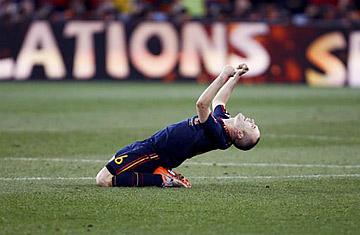
Spain's Andres Iniesta celebrates after the final whistle at the Spain-Netherlands 2010 World Cup final soccer match at Soccer City stadium in Johannesburg, South Africa
It's no secret that with an array of cable channels, video games and the Internet competing for viewers' attention, the audiences for network television are eroding. These days, even the biggest hits are suffering: average viewership for the Wednesday-night broadcast of Fox's American Idol, for instance, was down 14% from last season. The audience for CSI, on CBS, dropped nearly 19% from 2009 to 2010; the Tuesday-night broadcasts of ABC's Dancing with the Stars fell 9.2%, according to Nielsen data.
But amid these sagging performances, television appears to be experiencing a resurgence in a surprising place: sports programming. Of the 13 television programs that drew more than 30 million viewers over the past year, 11, or 85%, were sports-related, according to a new research report from Horizon Media, a media buying and planning agency. The only non-sports-related shows were the Oscars and the first episode of the CBS reality show Undercover Boss — which debuted immediately following the network's broadcast of the Super Bowl. Back in the 2004-05 television season, 19 programs hit the 30 million mark, and only nine, or 47%, were sports shows.
Any conversation about a sports resurgence must begin with football. This year's Super Bowl, between the New Orleans Saints and the Indianapolis Colts, was the most watched television show in U.S. history, as it averaged 106.5 million viewers throughout the broadcast, up 8% from last year. The NFC championship game was up 51% from last year, the AFC game saw a 15% rise, and regular-season ratings jumped as well.
And the NFL, by far the most successful pro sports league, isn't the only one enjoying astounding success. The 2010 Kentucky Derby was the most watched horse race since 1989. The Stanley Cup turned in its strongest ratings performance in 13 years, and Game 6 between the Chicago Blackhawks and the Philadelphia Flyers, a 4-3 Blackhawks overtime win that gave Chicago its first Stanley Cup victory since 1961, was the most watched NHL game in 36 years. Compared with 2006, average World Cup soccer viewership was up 41% on ABC and ESPN.
In college basketball, the 23.9 million TV audience for the championship game between Duke and Butler was the highest since 1999 and a 36% leap over 2009. In college football, viewership for the BCS championship game, between Alabama and Texas, reached 30 million for only the second time in the 12-year history of the event. The NBA enjoyed its most watched finals since 2001; baseball, its best World Series performance since 2004; the Winter Olympics, the second most watched Games in its history. The Vancouver Games trail only the 1994 event in Lillehammer, home to the infamous Tonya Harding–Nancy Kerrigan skating scandal, in total viewership. In fact, the Winter Olympics became the first program to beat American Idol head to head in six years.
Not all sports events are rising, though. Baseball's 2010 All-Star Game turned in the midseason game's lowest ratings ever. Perhaps viewers are finally fed up with the ridiculous rule that grants World Series home-field advantage to the league that wins this exhibition. NASCAR is suffering a notable slide; tennis surely isn't tearing it up; and while the Masters performed well because of the Tiger Woods comeback, golf is still too dependent on Tiger's success, and his recent woes are hurting ratings.
Still, for the most part sports are surging, and the question is why. "I think part of it is HDTV," says Brad Adgate, senior vice president of research at Horizon Media and author of the new report. "It's the killer app for sports." According to the Consumer Electronics Association, 65% of U.S. homes now own at least one high-definition television set, an increase of 13 percentage points from last year. And sports ratings are 21% higher on HDTVs, according to Nielsen. While watching American Idol in HD is surely nice, getting a glimpse of Ryan Seacrest's dimples isn't quite as exhilarating as feeling you're right on the football field. "With HD, you get to see the blades of grass and the beads of sweat," says Adgate. "It's a much richer viewing experience."
DVRs have cut down on appointment television; people are consuming their favorite shows whenever they want, wherever they want. Sports events, however, still offer morning-after watercooler fodder. The drama lies in the live action; if you wait two days to watch, you'll miss out. Give the Web credit too. The Internet hasn't cannibalized sports viewership, as many expected; it has complemented it. Social-media sites like Twitter and Facebook have turned games into communal experiences, and even casual fans are eager to join the conversation. Sports lend themselves to in-game analysis (and snark) in a way that prime-time programs don't. Fans can't resist the opportunity to be their own color commentator.
Sports, it must be pointed out, have also benefited from pure luck. As the Horizon report notes, the three largest U.S. markets — New York, Los Angeles and Chicago — have the reigning champions in pro baseball, basketball and hockey, respectively. For the first time since 1993, the top seeds in both football conferences met in the Super Bowl, and the New Orleans story line — a hard-luck city, and franchise, chases its first title — made the game an even bigger draw. The USA-Canada gold-medal Olympic hockey game and the USA-England opening-round World Cup soccer game were dream matches.
Of course, an unsexy World Series (think San Diego Padres vs. Texas Rangers) or hockey finals matchup (Edmonton Oilers–Ottawa Senators) could quickly halt some of this momentum. But as long as the technology keeps advancing — sports futurists couldn't be more bullish about 3-D TV — and Twitter lets you yell at the ref from the comfort of your couch, odds are, we'll stay glued to the games.
